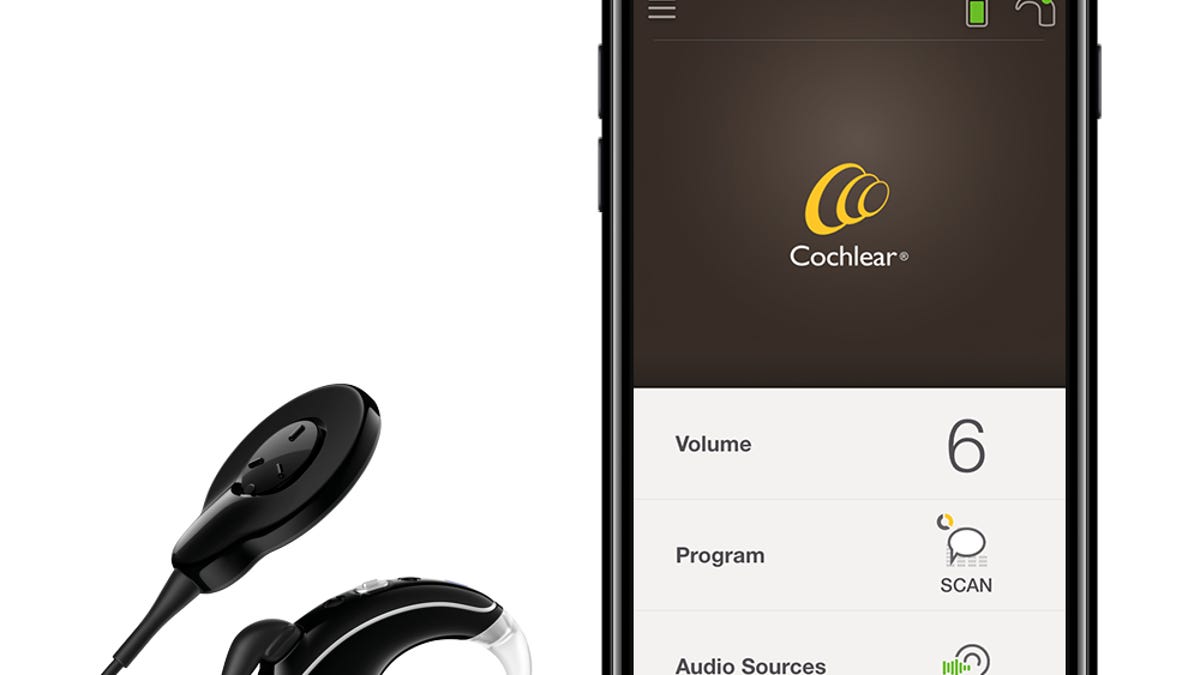This implant beams sound directly to your brain from an iPhone
The Nucleus 7 Sound Processor uses iOS to help people with hearing loss listen to high-quality calls and music.

The Nucleus Smart App allows users to check their cochlear implant's battery life and control volume.
This is part of CNET's "Tech Enabled" series about the role technology plays in helping the disability community.
Mathias Bahnmueller is using his iPhone 6 to hear again.
Several years ago, Bahnmueller began losing his hearing. He was diagnosed with Meniere's disease, a disorder of the inner ear that causes vertigo, tinnitus and hearing loss.
Last month, the 49-year-old auto industry executive received a cochlear implant called the Nucleus 7 Sound Processor to help improve his hearing. The implant, made by Cochlear Ltd., also connects with an iPhone app to deliver streaming sound to his auditory nerve and then the brain. The device, which was unveiled on Wednesday, will be available in the US and Canada in September.
Bahnmueller said the implant made all the difference in the world.
"It basically allowed me to participate in more social settings again," Bahnmueller said, adding that a year ago he wouldn't have been able to have this conversation with me at all.
The Nucleus 7 is one of a growing number of Made for iPhone hearing devices, including products made by ReSound, Starkey and Beltone. It's also the first cochlear implant to be part of the family of Apple-compatible products.
Cochlear implants differ from conventional hearing aids in key ways. As the name suggests, the devices are embedded inside a patient's body and aren't removable without a surgical process. Rather than amplify sound, like hearing aids do, cochlear implants send sound directly to the auditory nerve.
Around 360 million people have disabling hearing loss, according to the World Health Organization. (Disabling hearing loss refers to loss of hearing of 40 decibels in adults and 30 decibels in children.) The number is expected to jump to 1.2 billion by 2050.
Even with the help of hearing aids and cochlear implants, activities like talking on the phone or listening to music can be challenging for people with hearing problems. In 2014, Apple began licensing its Bluetooth Low Energy audio technology to hearing aid and implant makers. The technology can be used to beam sound from iOS devices, as well as perform other tasks, such as checking an implant's battery life and controlling its volume. Apple offers the licenses without charge.
With the free Nucleus Smart App on iOS, users can monitor and customize their hearing depending on whether they're in a loud restaurant or in a quiet park.
"The fact that people can now manipulate and control their device from an app does make it less intrusive," said Jan Janssen, Cochlear's global head of research and development.
Settings can be reached by triple-clicking the iPhone's home button. The process for pairing the Nucleus 7 is the same as for any Bluetooth device.
Sarah Herrlinger, a senior manager for global accessibility policy and initiatives at Apple, said Made for iPhone is an example of the company's ability "to look at problems people have in the world and try to solve them in really innovative ways."
Janssen said people who receive a cochlear implant often have profound hearing loss in both ears. In many countries, however, insurance companies will only reimburse an implant for one ear so people end up using a conventional hearing aid for the other.
To address that situation, Cochlear is developing the Bimodal Solution, which streams synchronized audio to each ear via an iOS device.
One of the hardest things for Bahnmueller before receiving the cochlear implant was that he had a difficult time understanding his 14-year-old daughter Sofia, who is soft-spoken. He's now not only able to speak with her more easily, but also can enjoy listening to her practice the violin without it sounding distorted.
"It improved what I understood in private settings, as well as at a workplace setting," he said.
Tech Enabled: CNET chronicles tech's role in providing new kinds of accessibility.
Intolerance on the Internet: Online abuse is as old as the internet and it's only getting worse. It exacts a very real toll.

